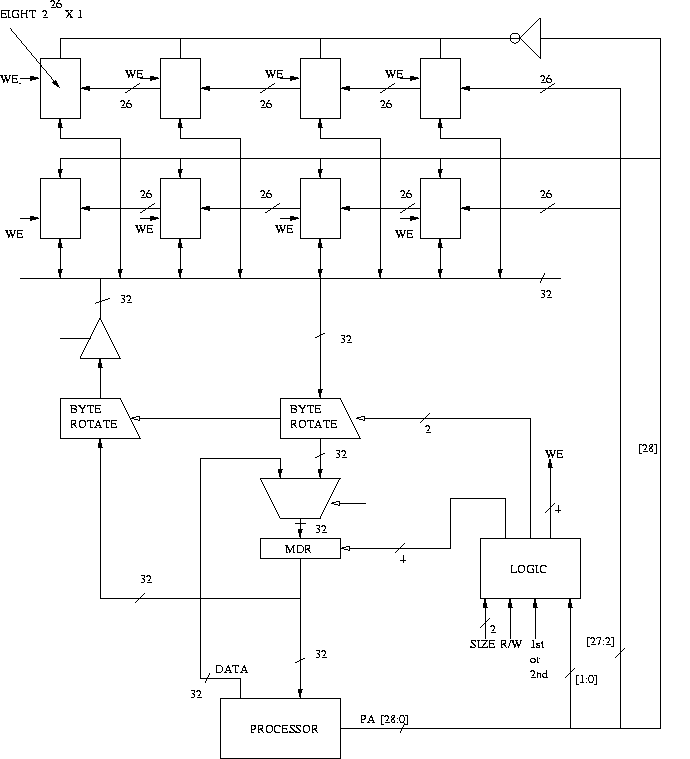
- What signal should be used for the select signal of the mux (in front of the MDR) and the enable signal of the tristate buffer (connected between the data bus and the rotator)?
- Construct the truth table to implement the LOGIC block, having inputs PHYS_ADDR[1:0], SIZE, R/W, 1st or 2nd access, and the outputs shown in the above figure. Assume that the value of SIZE can be Byte (00), HalfWord (01), and Word (10). Clearly explain what function each output serves.
| Frame 0 | empty |
| Frame 1 | Page 13 |
| Frame 2 | Page 5 |
| Frame 3 | Page 2 |
| Frame 4 | empty |
| Frame 5 | Page 0 |
| Frame 6 | empty |
| Frame 7 | Page Table |
A three-entry Translation Lookaside Buffer that uses LRU replacement is added to this system. Initially, this TLB contains the entries for pages 0, 2, and 13. For the following sequence of references, put a circle around those that generate a TLB hit and put a rectangle around those that generate a page fault. What is the hit rate of the TLB for this sequence of references? (Note: LRU policy is used to select pages for replacement in physical memory.)
References (to pages): 0, 13, 5, 2, 14, 14, 13, 6, 6, 13, 15, 14, 15, 13, 4, 3.
At the end of this sequence, what three entries are contained in the TLB? What are the contents of the 8 physical frames?
Assume that the virtual memory system added uses a one-level translation scheme and the page table is always resident in physical memory.
An instruction is said to generate a page fault if a page fault occurs at any time during the processing of that instruction.
Virtual Memory Size : 4 Kbytes (12 bit address-space)
Page Size : 32 bytes
PTBR : 0x380
SBR : 0x1E0
The virtual memory system is similar to the VAX in which virtual memory is divided
into System Space and User Space. The system page table remains resident in physical memory.
Each PTE contains, in addition to the PFN, a Valid bit, a modified bit and 2 bits for access
control. The format of the PTE entry is
| Valid | Modified | Access Control | PFN |
- How many virtual pages does the system acomadte?
- What is the size of the PFN? How big is the PTE?
- How many bytes are required for storing the entire page table? How many pages does this
correspond to?
Since the page table can occupy a significant portion of the the physical memory, this system uses a 2 level address translation scheme, by storing the Page Table's in virtual memory(Similar to the VAX). - Given the virtual address 0x7AC what is the Physical address?
To help you, the following table shows the contents of the physical memory that you may need to do the translation :
Address Data x1F8 xBA x1F9 xBB x1FA xBC x1FB xBD x1FC xBE x1FD xB8 x1FE xB7 x1FF xB6 Address Data x118 x81 x119 x72 x11A x65 x11B x34 x11C x97 x11D x83 x11E xC6 x11F xB2
Remember that in VAX each Vitual Adress consists of 2 bits to specify the Address Space 21 bits to specify Virtual Page Number 9 bits to specify the byte on the page
You will need to know the contents of P0BR: x8AC40000 and SBR: x000C8000.
You will also need to know the contents of the following physical memory locations:
x1EBA6EF0: x80000A72Some intermediate questions to help you:
x0022D958: x800F5D37
- What virtual page of P0 Space is x on?
- What is VA of the PTE of the page containing x?
- What virtual page of System Space is this PTE on?
- What is the PA of the PTE of this page of System Space?
- What is the PA of the PTE of the page containing x?